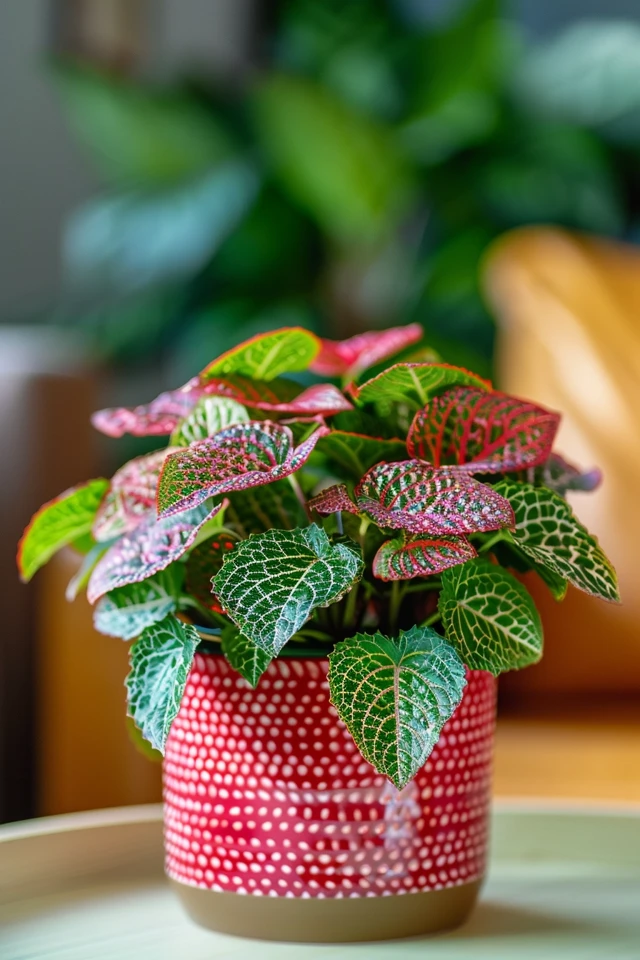Growing a Fittonia plant, also known as the “nerve plant” or “mosaic plant,” can bring vibrant colors and lushness to any indoor space. If you want your Fittonia to flourish and develop a bushy growth habit, there are some essential care tips to keep in mind. By providing the right conditions and attention, you can ensure that your Fittonia thrives and becomes a stunning centerpiece in your home.
To encourage fuller growth in your Fittonia plant, it’s crucial to understand its specific care needs. This includes considerations such as creating a humid atmosphere, providing proper lighting, pruning when necessary, and ensuring balanced nutrition. By implementing these practices, you can help your Fittonia achieve its full potential and add a touch of natural beauty to your space.
Key Takeaways:
- Creating a humid environment is essential for the healthy growth of Fittonia plants.
- Place your Fittonia plant in a sun-facing window to provide the right amount of indirect light.
- Prune your Fittonia regularly to promote fuller growth and maintain its shape.
- Consider propagating Fittonia through stem cuttings to expand your collection.
- Provide balanced nutrition to your Fittonia plant through appropriate fertilizer application.

How To Create a Humid Atmosphere for Fittonia
Fittonia plants thrive in high humidity environments, which can be challenging to provide in certain indoor settings. To create a humid atmosphere for your Fittonia, you can employ several effective methods:
- Misting: Regularly mist the leaves of your Fittonia plant with water using a spray bottle. This helps to increase humidity around the plant by providing a fine mist of moisture.
- Humidifier: Place a humidifier near your Fittonia plant. This device releases moisture into the air, creating a more humid environment that mimics the natural conditions Fittonia plants prefer.
- Terrarium: Create a miniature terrarium for your Fittonia by placing it in a glass container with a lid. This enclosed environment helps to trap moisture and increase humidity around the plant.
- Grouping: Group multiple Fittonia plants together. As they release moisture through transpiration, they create a microclimate that increases humidity levels for each other.
By ensuring adequate humidity, you can help your Fittonia plant avoid withering or dying and promote fuller growth.
Creating a humid atmosphere is essential for the health and vitality of your Fittonia plant. With these methods, you can provide the optimal conditions for your plant to thrive.
Providing Proper Lighting for Fittonia
Fittonia plants require a balance of indirect light and shade to thrive and achieve their full potential, as they naturally grow in jungly environments. When caring for your Fittonia indoors, it’s essential to provide it with proper lighting to ensure its bushy growth and vibrant colors.
One of the best ways to provide adequate lighting for your Fittonia is to place it in a sunny window that faces the sun. This will allow the plant to receive a steady and strong indirect light throughout the day, simulating its natural habitat. The sunlight filtering through the window will provide the optimal amount of light for your Fittonia to thrive.
If you have a Fittonia plant in your garden, it’s important to choose a shaded spot that still receives some direct sunlight. Avoid placing your Fittonia in an area that is exposed to excessive direct sunlight, as it can potentially scorch the leaves and harm the plant’s overall health.
Remember, each Fittonia plant has unique light requirements, and it’s crucial to find the right balance for your specific plant. Observing the plant’s response to light and adjusting its placement accordingly will help you provide the ideal lighting conditions for your Fittonia.
“Proper lighting is crucial for the healthy growth of Fittonia plants. Providing the right balance of indirect light and shade will help them flourish and maintain their vibrant colors.”

Benefits of Proper Lighting for Fittonia
- Promotes bushy growth: By providing the necessary lighting conditions, you can encourage your Fittonia to grow fuller and bushier, creating a more lush and compact appearance.
- Maintains vibrant colors: Adequate lighting ensures that your Fittonia’s leaves retain their vibrant colors, showcasing the plant’s stunning patterns and adding visual interest to your indoor or outdoor space.
- Supports photosynthesis: Fittonia plants rely on photosynthesis to produce energy and maintain their overall health. The right amount of light will enable them to effectively carry out this essential process.
- Prevents etiolation: Insufficient lighting can lead to stretching and weak growth, resulting in leggy and less attractive plants. Providing proper lighting helps prevent etiolation and promotes sturdy, compact growth.
By understanding and meeting the lighting requirements of your Fittonia plant, you can create the ideal conditions for its growth and enjoy a healthy, bushy, and vibrant addition to your home or garden.

Pruning and Propagation Tips for Fittonia
Pruning is an essential aspect of Fittonia plant care that can help promote fuller growth and maintain the plant’s shape. To prune your Fittonia, use sharp and sterile shears to trim back any leggy or unruly stems. Pruning during the growing season, such as in spring, is recommended as it encourages new growth.
Another way to encourage fuller growth in Fittonia is through propagation. You can easily propagate Fittonia plants through stem cuttings. Simply cut a stem just below a leaf node, plant it in moistened potting mix, and place it in a warm and bright location. Within a few weeks, roots should start to develop. Once the roots are established, you can transplant the new plants into larger pots.
By incorporating pruning and propagation techniques into your Fittonia plant care routine, you can encourage fuller growth and expand your collection of these beautiful houseplants. Remember to prune during the growing season and propagate with stem cuttings to ensure optimal results.

